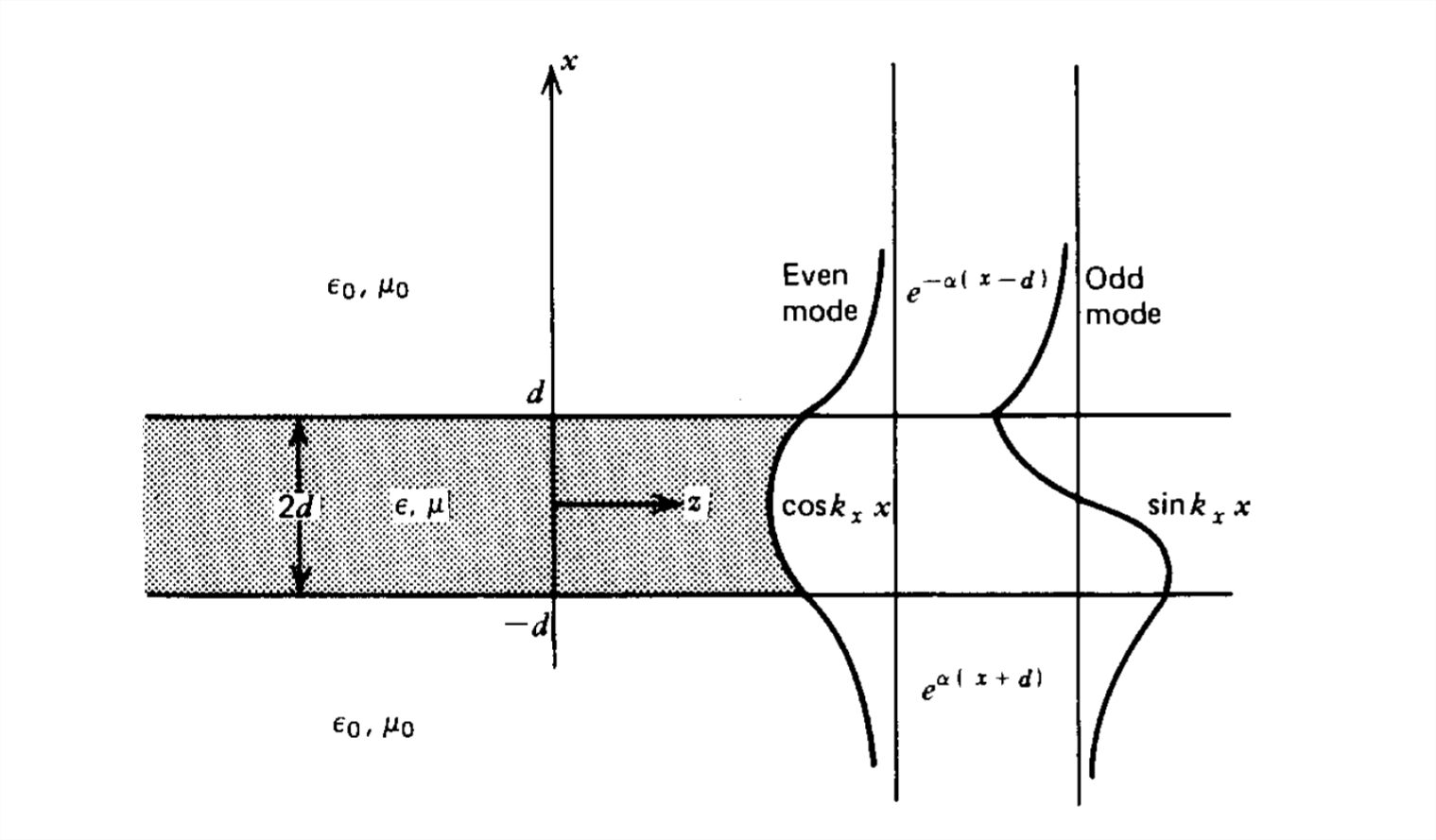8.7: Dielectric Waveguide
( \newcommand{\kernel}{\mathrm{null}\,}\)
We found in Section 7-10-6 for fiber optics that electromagnetic waves can also be guided by dielectric structures if the wave travels from the dielectric to free space at an angle of incidence greater than the critical angle. Waves propagating along the dielectric of thickness 2d in Figure 8-30 are still described by the vector wave equations derived in Section 8-6-1.
TM Solutions
We wish to find solutions where the fields are essentially confined within the dielectric. We neglect variations with y so that for TM waves propagating in the z direction the z component of electric field is given in Section 8-6-2 as
Ez(x,t)={Re[A2e−α(x−d)ej(ωt−kzz)],x≥dRe[(A1sinkxx+B1coskxx)ej(ωt−kzz)],|x|≤dRe[A3eα(x+d)ej(ωt−kzz)],x≤−d

where we choose to write the solution outside the dielectric in the decaying wave form so that the fields are predominantly localized around the dielectric.
The wavenumbers and decay rate obey the relations
k2x+k2z=ω2εμ−α2+k2z=ω2ε0μ0
The z component of the wavenumber must be the same in all regions so that the boundary conditions can be met at each interface. For propagation in the dielectric and evanescence in free space, we must have that
ω2ε0μ0<kz<ω2εμ
All the other electric and magnetic field components can be found from (1) in the same fashion as for metal waveguides in Section 8-6-2. However, it is convenient to separately consider each of the solutions for Ez within the dielectric.
(a) Odd Solutions
If Ez in each half-plane above and below the centerline are oppositely directed, the field within the dielectric must vary solely as kxx:
ˆEz={A2e−α(x−d),x≥dA1sinkxx,|x|≤dA3eα(x+d),x≤−d
Then because in the absence of volume charge the electric field has no divergence,
∂ˆEx∂x−jkzˆEz⇒ˆEx={−jkzαA2e−α(x−d),x≥d−jkzkxA1coskxx,|x|≤djkzαA3eα(x+d),x≤−d
while from Faraday's law the magnetic field is
ˆHy=−1jωμ(−jkzˆEx−∂ˆEz∂x)⇒ˆHy={−jωε0A2αe−α(x−d),x≥d−jωεA1kxcoskxx,|x|≤djωε0A3αeα(x+d),x≤−d
At the boundaries where x=±d the tangential electric and magnetic fields are continuous:
Ez(x=±d−)=Ez(x=±d+)⇒A1sinkxd=A2−A1sinkxd=A3Hy(x=±d−)=Hy(x=±d+)⇒−jωεA1kxcoskxd=−jωε0A2α−jωεA1kxcoskxd=jωε0A3α
which when simultaneously solved yields
A2A1=sinkxd=εαε0kxcoskxdA3A1=−sinkxd=−εαε0kxcoskxd}⇒α=ε0εkxtankxd
The allowed values of α and kx are obtained by self-consistently solving (8) and (2), which in general requires a numerical method. The critical condition for a guided wave occurs when α=0, which requires that kxd=nπ and k2z=ω2ε0μ0. The critical frequency is then obtained from (2) as
ω2=k2xεμ−ε0μ0=(nπ/d)2εμ−ε0μ0
Note that this occurs for real frequencies only if εμ>ε0μ0.
(b) Even Solutions
If Ez is in the same direction above and below the dielectric, solutions are similarly
ˆEz={B2e−α(x−d),x≥dB1coskxx,|x|≤dB3eα(x+d),x≤−d
ˆEx={−jkzαB2e−α(x−d),x≥djkzkxB1sinkxx,|x|≤djkzαB3eα(x+d),x≤−d
ˆHy={−jωε0αB2e−α(x−d),x≥djωεkxB1sinkxx,|x|≤djωε0αB3eα(x+d),x≤−d
Continuity of tangential electric and magnetic fields at x=±d requires
B1coskxd=B2,B1coskxd=B3jωεkxB1sinkxd=−jωε0αB2,−jωεB1kxsinkxd=jωε0B3α
or
B2B1=coskxd=−εαε0kxsinkxdB3B1=coskxd=−εαε0kxsinkxd}⇒α=−ε0kxεcotkxd
TE Solutions
The same procedure is performed for the TE solutions by first solving for Hz.
(a) Odd Solutions
ˆHz={A2e−α(x−d),x≥dA1sinkxx,|x|≤dA3eα(x+d),x≤−d
ˆHx={−jkzαA2e−α(x−d),x≥d−jkzkxA1coskxx,|x|≤djkzαA3eα(x+d),x≤−d
ˆEy={jωμ0αA2e−α(x−d),x≥djωμkxA1coskxx,|x|≤d−jωμ0αA3eα(x+d),x≤−d
where continuity of tangential E and H across the boundaries requires
α=μ0μkxtankxd
(b) Even Solutions
ˆHz={B2e−α(x−d),x≥dB1coskxx,|x|≤dB3eα(x+d),x≤−d
ˆHx={−jkzαB2e−α(x−d),x≥djkzkxB1sinkxx,|x|≤djkzαB3eα(x+d),x≤−d
ˆEy={jωμ0αB2e−α(x−d),x≥d−jωμkxB1sinkxx,|x|≤d−jωμ0αB3eα(x+d),x≤−d
where α and kx are related as
α=−μ0μkxcotkxd


